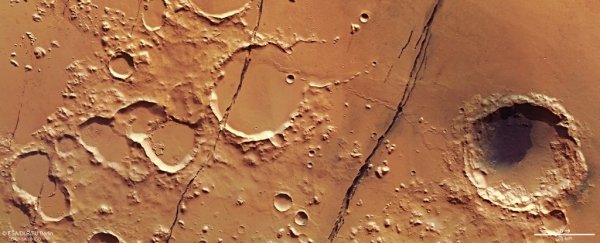It turns out that Mars is rumblier than we knew. New techniques have revealed previously undetected quakes beneath the Martian surface – and, scientists say, the best explanation so far is ongoing volcanic activity.
The evidence seems to be mounting that Mars is far from dead, but hosts, underneath its dusty, barren surface, an interior gurgling away with seismic activity.
"Knowing that the Martian mantle is still active is crucial to our understanding of how Mars evolved as a planet," says geophysicist Hrvoje Tkalčić of the Australian National University in Australia.
"It can help us answer fundamental questions about the Solar System and the state of Mars' core, mantle, and the evolution of its currently-lacking magnetic field."
For a very long time, scientists believed that nothing much was going on inside Mars.
The planet has very little in the way of a magnetic field. Planetary magnetic fields are (usually) generated inside the planet, by something called a dynamo – a rotating, convecting, and electrically conducting fluid that converts kinetic energy into magnetic energy, spinning a magnetic field out into space.
Mars' lack of a magnetic field suggests a lack of activity. This is a big deal; in fact, a magnetic field can mean the difference between life and death. Here on Earth, the magnetic field protects us from cosmic radiation that might destroy life. On Mars, radiation levels are much higher, even though it is more distant from the Sun.
"All life on Earth is possible because of the Earth's magnetic field and its ability to shield us from cosmic radiation, so without a magnetic field life as we know it simply wouldn't be possible," Tkalčić explains.
But when NASA's InSight lander arrived in November 2018 and started listening for Mars' heartbeat, we learnt something really remarkable: Mars is rumbling. To date, InSight has detected hundreds of marsquakes – enough to give us a detailed map of the Martian interior.
Tkalčić and his colleague, geophysicist Weijia Sun of the Chinese Academy of Sciences, wanted to look for quakes that might have gone unnoticed in the InSight data. They used two unconventional techniques, only recently applied to geophysics, to hunt seismic events in the InSight data.
Based on nine templates of known marsquakes, the pair detected 47 new seismic events, coming from a region on Mars called the Cerberus Fossae – a system of fissures created by faults that have pulled the crust apart.
Most of those new seismic events resemble the waveforms of two notable Cerberus Fossae quakes that took place in May and July of 2019, suggesting that the smaller quakes are related to the larger ones.
Then the researchers sought to figure out the cause of the quakes. Their analysis found that there was no pattern to be found in the timing of the quakes, ruling out causes such as the influence of Martian moon Phobos.
"We found that these marsquakes repeatedly occurred at all times of the Martian day, whereas marsquakes detected and reported by NASA in the past appeared to have occurred only during the dead of night when the planet is quieter," Tkalčić says.
"Therefore, we can assume that the movement of molten rock in the Martian mantle is the trigger for these 47 newly detected marsquakes beneath the Cerberus Fossae region."
Previous analysis of features on the surface of Mars at the Cerberus Fossae found that the region had been volcanically active recently, within the last 10 million or so years.
The activity identified by Sun and Tkalčić, attributed to the repetitive movement of magma in the Martian mantle, also suggests that Mars is more volcanically and seismically active than we thought.
If this is the case, the results have implications for our understanding of the history of Mars – and its future.
"The marsquakes indirectly help us understand whether convection is occurring inside of the planet's interior, and if this convection is happening, which it looks like it is based off our findings, then there must be another mechanism at play that is preventing a magnetic field from developing on Mars," Tkalčić says.
"Understanding Mars' magnetic field, how it evolved, and at which stage of the planet's history it stopped is obviously important for future missions and is critical if scientists one day hope to establish human life on Mars."
The research has been published in Nature Communications.
